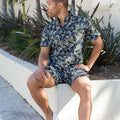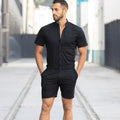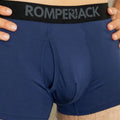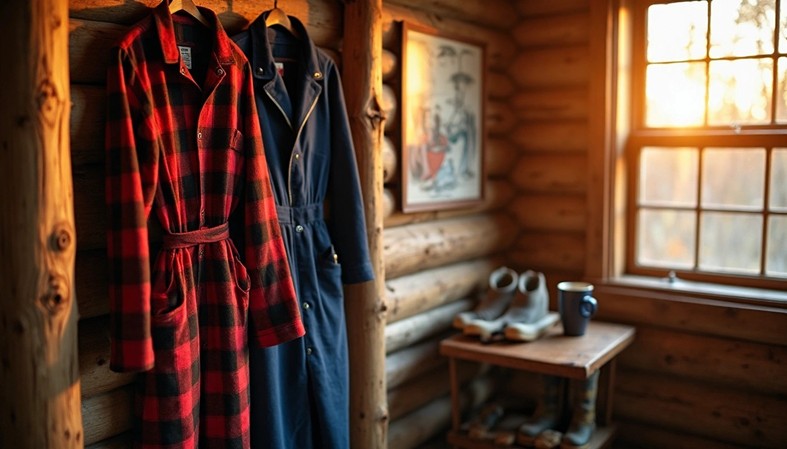Here's a fascinating fact: the union suit, our modern comfort wear icon, was created as "emancipation union under flannel" in Utica, New York, in 1868. Victorian ladies had to endure wearing up to 13 pieces of underwear at once, which weighed an astonishing 7-10 pounds!
The union suit's story took an unexpected turn. Though designed to free women from restrictive clothing, men quickly embraced it for its practicality, warmth, and comfort. Munsingwear produced 30,000 garments daily by 1917 to meet the growing needs. This one-piece wonder remained popular as workingmen's attire until the mid-20th century, and has seen a comeback during the pandemic as people value comfort while working from home.
This piece will help you understand what makes men's union suits unique and how to pick the perfect one. You'll learn everything about their design features and the best materials for different uses, whether you want a thermal union suit for outdoor activities or a relaxed option for home wear.
What is a Union Suit?
The union suit is a unique piece of clothing that comes with an interesting history and special features. Let's look at what makes this garment stand out and why people still wear it today.
Definition and simple structure
A union suit is a that covers the body from wrists to ankles. The full-body coverage helps trap body heat effectively. Red flannel was the traditional material of choice, and the classic design features long arms and legs with buttons running up the front.
The union suit's most distinctive feature is its button-up flap at the back that covers the buttocks. People have given this practical design element many colorful names like "access hatch," "drop seat," "fireman's flap," and several other informal terms. Some union suits can have from neck to groin, depending on their size and style.
Today's union suits keep these basic contours but use modern materials. Manufacturers have added zippers and elastic to make them more comfortable and convenient.
Why it's called a 'union' suit
The story behind the name "union suit" remains a bit of a mystery. Several theories try to explain its origins. The most likely explanation suggests the name comes from the literal "union" of top and bottom garments into one piece. This makes sense because the garment combines a shirt and drawers into a single piece.
Some think the name links to the Union Army, while others believe it might come from an old, forgotten brand. Susan Marks, a historian, points out that "historians are not in agreement on the etymology". We lack detailed historical records because people once saw undergarments as "unmentionables" and didn't think they deserved documentation.
Common misconceptions
The biggest misunderstanding about union suits relates to who they were made for. Many associate them with men—cowboys, prospectors, and rural workers specifically—but women were the original target market. The union suit came about during the Victorian dress reform movement as an alternative to tight corsets and heavy undergarments.
In stark comparison to this rustic image, union suits weren't always seen as just practical garments. The original "emancipation union under flannel" brought a revolutionary change to undergarments. Fashion trends later pushed the union suit into what we know today—something worn in rural areas and cold climates where staying warm matters more than style.
The Surprising History of Union Suits
The union suit has one of the most interesting origin stories in clothing history. Most people think it was made for male outdoorsmen, but its real beginnings tell a different tale.
Origins in Victorian women's fashion reform
The story starts with bold women who wanted to break free from fashion's limits, not with tough outdoorsmen. Victorian women had to wear at once, which weighed between 7-10 pounds. The corset was the biggest offender, with a tiny 20-22 inch measurement around the waist between 1860-1910.
These tight clothes caused serious health problems. Women suffered from "Chicken Breast" where ribs turned inward and overlapped the sternum. They also had compressed lungs, poor digestion, and uterine damage. The need for healthier options became clear.
A major breakthrough came in 1868 with the patent for the "emancipation union under flannel". This new piece combined a knit flannel shirt and pants into one, which meant women could finally ditch their corsets. Susan Taylor Converse made it even better in 1875 with her "Emancipation Suit" that had a gathered bodice to free the breasts from pressure.
Adoption by men and working-class America
Men soon saw how practical the union suit could be, despite its women's wear roots. The one-piece design kept them warm without gaps between clothes, and it was easy to use with front buttons and a rear drop seat.
Workers in cold places found these suits were a great way to get through tough conditions. Many wore the same suit for a week straight, and some kept it on all winter. The garment's role changed from women's revolutionary wear to something mainly worn by rural and working-class men.
The role of Munsingwear in popularizing them
George D. Munsing started the Northwestern Knitting Company (later Munsingwear) in Minnesota in 1886. He solved the biggest problem with wool underwear - the itch. His method of putting silk over wool created warm undergarments that didn't irritate the skin[93].
The company made waves in 1897 with a bold Ladies' Home Journal ad that showed a young girl in a union suit. This was the first time anyone had shown underwear on a real person instead of just laying flat. Their risk paid off big time. By 1900, they sold 80 different types of long underwear, and their daily production reached by 1917.
Design Features That Make Union Suits Unique
The union suit stands out not just because of its place in history, but also thanks to its unique design elements. These features make it easy to spot and incredibly practical across generations. Few other garments can match how it balances practicality with comfort.
The drop seat (aka butt flap)
The traditional union suit's most recognizable feature is without doubt its rear flap. People know this practical design element by several colorful nicknames like "drop seat," "access hatch," "fireman's flap," and other less polite terms. The buttoned flap that covers the buttocks serves a simple purpose - it lets you take bathroom breaks without taking off the whole garment.
This innovation proved really convenient and kept you warm, especially in cold weather or work settings. The rear flap has become a bit of a joke in popular culture. Red union suits shown from behind often pop up as mild toilet humor in movies and TV shows.
Button-up front and full-body coverage
Classic union suits came with a long line of buttons from neck to groin. Original models could have , though newer designs are more efficient with 8-button placket closures. All these buttons made the suit easy to put on while keeping it snug and warm.
The one-piece design sets these suits apart from regular two-piece underwear. It offers complete coverage without any exposed skin that's hard to adjust under other clothes. This full protection really helps when you're wearing multiple layers in extreme weather.
Modern updates: zippers, elastic, and more
Modern union suits keep their classic look but add many new features. The design stands out as it removes all buttons, zippers, and snaps to boost comfort and durability. Today's suits also offer:
· Flatlock seams that prevent chafing
· Drawstring waists you can adjust for the perfect fit
· Thumbholes that make layering easier and keep hands warm
· Tagless labels so nothing irritates your neck
New designs separate men's and women's styles too. Men's suits have the usual relief flap in front, while women's versions include a drop seat in back. These smart updates keep the union suit's basic purpose intact while making it more comfortable to wear.
Choosing the Right Union Suit for Home and Outdoors
The perfect union suit balances comfort, function, and climate needs. Your choice will change substantially based on whether you need it to lounge indoors or brave harsh outdoor conditions.
Thermal union suit vs. lightweight cotton
Your environment dictates the choice between thermal and lightweight options. Thermal union suits trap body heat with their waffle knit pattern that works great in cold weather. Lightweight cotton breathes better for indoor use or milder temperatures. Cotton holds moisture though, making it a poor choice when you might sweat.
Best materials for warmth and comfort
Wool blends and advanced synthetics provide maximum warmth:
· Keep you warm with their 40-50% wool content that insulates even when wet Merino wool union suits
· High-quality synthetics like 4-way stretch polyester fleece deliver warmth without bulk
· Cotton-polyester blends mix comfort with durability at 60% cotton and 40% polyester
Technical union suits now use silver nitrate in fabrics to cut down odor during long wear periods.
Fit and sizing tips for men's union suits
A good union suit should fit snug without limiting your movement. The sizing guides show fit heights from 5'8" to 6', while tall sizes work for people between 6'1" and 6'3". Most makers add 2" in length as sizes go up.
Key points to think over:
· Torso length varies by brand with some running longer
· Sleeve and pant length work best with ribbed cuffs
· Synthetic blends flex more than other materials
Top brands: Romperjack, Carhartt, L.L.Bean
Leading brands stand out in different ways. Carhartt's rugged Flex stretch technology makes them last longer. L.L.Bean creates premium two-layer suits with a 50% cotton/40% wool/10% nylon blend. Romperjack focuses on high thread count cotton that feels great against your skin.
Union suits for lounging vs. outdoor work
Soft fabrics and front buttons make the best lounging suits. Outdoor activities need technical materials that handle sweat well—synthetics or wool work better than cotton. The North Face and Patagonia make specialized outdoor suits that keep you warm while skiing, hunting, or camping in cold weather.
Conclusion
Union suits have definitely made great strides since their surprising roots in women's liberation movements. These garments reshaped the scene from revolutionary undergarments to practical staples that outdoor enthusiasts and comfort-seekers love. Their lasting appeal comes from a perfect mix of warmth, practicality, and full-body coverage that other clothes can't match.
Your ideal union suit choice should start with its main purpose. Thermal options with merino wool blends excel in harsh outdoor conditions, while lightweight cotton versions are perfect for home comfort. Modern updates like flatlock seams, stretch fabrics, and tagless designs have substantially improved comfort compared to older versions.
The iconic drop seat remains the most recognizable feature of classic union suits. Modern versions now include zippers, elastic, and other convenient features. Brands like Carhartt, L.L.Bean, and Romperjack each bring something special - durability, premium materials, and comfort to the table.
The right union suit should match your need for warmth with features that fit your lifestyle. You might need one for winter outdoor work, or just want to welcome the cozy nostalgia while working from home. This classic piece of clothing history has without doubt earned its spot in modern wardrobes by combining function and comfort in one unique package.







